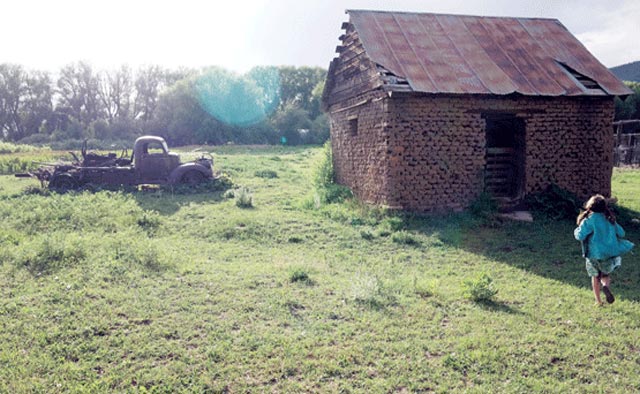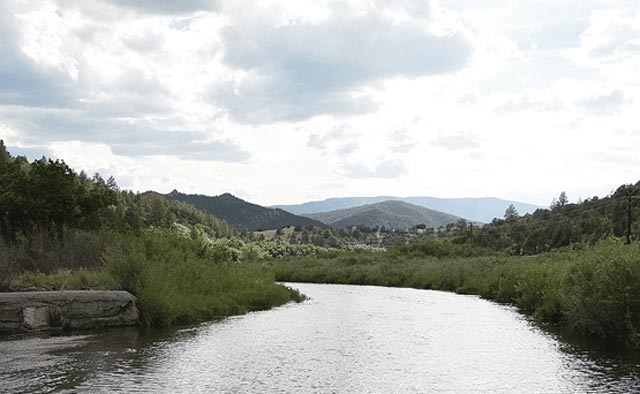
My parents live in Chacon, New Mexico, in a wind-chapped finger of high-mountain Mora Valley. My grandparents were determined to spend their last days there and are buried in Chacon’s campo santo. Every delicious summer of my childhood, I played in and along the Mora River, and now my children splash in the same cold mountain stream.
Energy companies are seeking permits to explore natural gas extraction through hydraulic fracturing, or fracking, in Mora County. But the area’s traditional livelihoods, farming and ranching, rely on clean, healthy rivers and streams. New Mexico has recently suffered several years of severe drought. Millions of gallons of water are used to frack, and water contamination and earthquakes are increasingly paired with this technology.
On a sunny afternoon last summer, I drove my daughters north to visit my parents. We made the 90-degree turn at Salman Raspberry Ranch, leaving the sweeping llano that stretches east of Las Vegas as Highway 518 begins to wind between tightly clustered hills of piñon, juniper, and ponderosa. Then the close-knit hills parted and the valley opened before us, the glistening coils of the Mora River wending through a lush field dotted with grazing cattle, cattails, and willow. As we got closer to my parents’ house, the girls pointed out familiar sights: the clinic where my mother worked as a nurse; Mora High School, where my father taught; and the recurring hand-painted signs bearing the image of a cow’s head and phrases like “Farming, not Fracking.”
In 2010, Mora County voters, worried about the mounting threat of fracking, elected John Olivas and Paula Garcia to the Mora County Commission. Both had voiced strong opposition to oil and gas extraction in the county. A local anti-fracking organization, Drilling Mora County, contacted the Community Environmental Legal Defense Fund (CELDF), which helps municipalities with a legal framework to support local self-governance. As a result, in April 2013, the Mora County Commission passed “The Mora County Community Water Rights and Local Self-Government Ordinance,” the first countywide ban on oil and gas extraction in the United States.
Mora’s community ordinance draws on the protection of state and federal constitutions and the Treaty of Guadalupe Hidalgo, the contract signed between the United States and Mexico at the end of the Mexican-American War, which has provisions that protect the property and civil rights of land-grant families in New Mexico. The ordinance places both the indigenous and civil rights of the community over those of corporations—and it has unleashed a flurry of media attention on the Mora community.
It also set off a litigious backlash from the oil and gas industry. The Independent Petroleum Association of New Mexico and three private landowners filed suit against the county in federal district court, and in mid-February 2014, a second lawsuit was filed by a subsidiary of Royal Dutch Shell, which leases state trust land in the eastern part of the county for 25 cents an acre.
Community ordinances like Mora’s are needed “to fill a void,” according to Eric Jantz, a staff attorney for New Mexico Environmental Law Center. Jantz says the “Halliburton loophole” (the energy-bill provision that exempts fracking from EPA regulations), congressional budget cuts, and lack of institutional will to deal with the environmental impacts of extractive industries weaken state and federal protections. If folks in the community put up a good fight, the deep-pocketed corporations take them to court, using what Jantz calls “a perversion of the 14th Amendment” to protect their property rights.
Jantz speculates that the oil and gas industry singled out Mora, “a poor, rural, largely minority community without resources,” purposefully as its battleground. He suspects the industry intends to use lawsuits to “squeeze the county into acquiescence.”
Should the plaintiffs win in court, a precedent would be set, and the industry would have more leverage to oppose other community ordinances in the state and across the country. Jantz points to the fact that no comprehensive geological surveys have been done in Mora County. The quantity of shale gas in the county is unknown; there may not even be enough to warrant drilling—or more specifically, hydraulic fracturing. To Jantz, this is evidence that the fight is about something bigger than access rights to Mora County’s hypothetical fossil fuel reserves. It’s a fight about rights: corporate vs. community.
Mora County Commissioner and fracking-ban champion Olivas agrees. He says he wants to protect the county from the sort of boom-and-bust industry he saw growing up in Grants, New Mexico, where his parents worked in the uranium mines. Now, Grants is a ghost town, and many of his parents’ friends and acquaintances have died from illnesses related to uranium exposure. Olivas also hopes to help set a precedent for other communities to keep fracking at bay. He believes that even the sort of strict regulations on fracking passed in other counties still provide an “in” for drilling.
 (Photo: Nina Bunker Ruiz)
(Photo: Nina Bunker Ruiz)
Other local residents disagree. Joseph Griego runs an organic farm in Mora with his wife, Ruth Ann. He showed me their raised beds of frost-hardy greens, the greenhouse with an aquaponics system he built himself, and a pen containing hens and two splendid Spanish heritage turkeys. After the tour, we went into the kitchen, where Ruth Ann was at the stove, sauteeing asparagus.
Sitting across from me at the kitchen table, Griego insisted he has tried to remain neutral on the fracking issue: He doesn’t believe the industry’s testimonials from farmers and ranchers saying fracking is safe, but he doesn’t believe what he regards as hyperbole from environmental groups either. He figures a good number of Hispanics, like him, don’t want fracking in Mora but see an outright ban as a bad idea and fundamentally an Anglo-driven initiative.
He doesn’t think Mora has a chance to win lawsuits brought by the energy corporations: “As a county we don’t have the money to figure it out in court—it could take years. Money’s going to talk, and we don’t have enough population base to say we don’t want this here.”
Griego explained that there aren’t many job opportunities in Mora Country. He wonders if local fracking would offer his son, a mechanical engineering major at New Mexico Tech, a career in the area.
Joining us at the table with a sleeping baby in her arms, Ruth Ann expressed a less ambivalent view than her husband’s. “I would hate to see fracking come in,” she said. “To me, it’s just one more thing that could hurt my family. We’re trying to raise our own food because we want to know where it comes from. What would it do to the food we grow?”
Griego finished our conversation with a phrase I hear often from Mora residents. Despite his doubts about the fracking ban, he still sees Mora’s struggle for community rights as “the good fight.”
Robert Howarth, a Cornell University professor of ecology and environmental biology, has seen the effects of hydraulic fracturing through his research in other communities. He says that some gas well sites in Texas, Utah, and Colorado had pristine air quality before gas development began just a few years ago and now have airborne benzene and elevated levels of ozone.
As much as 5 million gallons of water and chemical additives are used per frack job, says Howarth. Some of the chemical additives are toxic, and “fracking fluids extract radioactive substances such as thorium, uranium, radium, and toxic materials such as lead and arsenic from the shale.”
An average of 40 percent of frack fluids rises to the surface over the lifetime of a gas well, and there aren’t comprehensive systems for disposing of them: “In Texas, they inject the waste fluids deep underground into old, conventional gas wells, but there aren’t enough such wells for all the waste in many areas.” Howarth cites evidence that fracking is responsible for an increase in earthquakes.
Then there’s climate change. Clearly frustrated that natural gas is touted as cleaner than other fossil fuels, Howarth points out that natural gas is mostly methane, which has the largest greenhouse gas footprint of any fossil fuel. “Considering natural gas a ‘bridge fuel,’” he says, “is disastrous.”
The serious risks of fracking are frequently ignored by corporations and courts, says CELDF Executive Director Thomas Linzey. He’s seen the current system of law not only ignore but punish people who fight to protect their communities. “We pretend we live in a democracy, but as long as certain corporate-manufactured legal doctrines remain in place, it doesn’t matter what we want or what we do.”
These doctrines include corporate constitutional “rights,” preemption, and Dillon’s Rule, which makes community lawmaking subordinate to state legislatures and state agencies. This means, Linzey continues, that “what Mora has adopted isn’t just an ordinance; it’s a new constitution—a new system of governance, a huge shift, a movement.” By developing community ordinances, Mora County and more than 200 other communities across the nation are asserting their right to local self-governance to decide the future health of their environment and their communities.
 Joseph Griego on his organic farm with a Spanish heritage turkey. (Photo: Nina Bunker Ruiz)
Joseph Griego on his organic farm with a Spanish heritage turkey. (Photo: Nina Bunker Ruiz)
Olivas lost his seat as chairman of the county commission in June, casting doubt on the security of Mora County’s anti-fracking ordinance. His successor, George Trujillo, is not necessarily pro-fracking but believes an outright ban and the resulting lawsuits are too much of a financial burden for the cash-poor county and its taxpayers. However, a repeal of the ordinance would not be easy, much less automatic; it would require both a unanimous vote of the county commission and a referendum, effective only if two-thirds of the electorate votes to repeal.
“If we’re opposing an industry coming into our community, we need to show that we’re working for something positive,” says Anita LaRan, descendent of some of the first Mora inhabitants and co-founder of Collaborative Visions, an organization that works to establish local economy projects. The community is rallying around the idea and there are signs of progress: a newsletter, La Voz de Mora; the Mora Watershed Alliance, which aims to restore arroyos and riparian areas; a planned arts venue; and a produce co-op that supplies markets in Taos, Santa Fe, and Española. Community cohesion is the aim.
“We want to get people involved,” LaRan says. “We don’t want anything that divides the community.”
A specific aspect of the anti-fracking ordinance refers to the values of a community that understands the importance of place and interdependence. This section evokes the Spanish tradition of querencia as protection for the inherent indigenous rights of all the county’s inhabitants—human, plant, and animal.
“Querencia,” as it is used in the ordinance, means both a respect and love of place, and a safe haven from which one draws strength. Author Barry Lopez, in The Rediscovery of North America, suggests that the word carries a “sense of being challenged” and defines querencia as “a place in which we know exactly who we are. The place from which we speak our deepest beliefs.”
“A sense of place,” he warns, “must include, at the very least, a knowledge of what is inviolate about the relationship between a people and the place they occupy, and certainly, too, how the destruction of this relationship, or the failure to attend to it, wounds people.”
Defending that relationship is embedded in the county’s history. During the Mexican-American War, and despite terrible odds, Mora and a handful of outlying areas made up the only significant resistance to the U.S. occupation of New Mexico.
In January 1847, mountain valley rebels managed to repel the U.S. Army, pushing the troops out of Mora. When the Americans returned with fresh soldiers and artillery, they razed the town, burned the wheat fields, and confiscated every last scrap of food. Mora’s villagers, left with charred fields and rubble, chose to replant and rebuild rather than relocate.
Today, facing battle with another superior power—this time in court—the people of Mora County have drawn on their heritage of resistance and resilience. They’ve responded to the threat of fracking with an ordinance that asserts their right to self-governance. Despite political differences and financial uncertainty, they’re working to create a community-centered economy and to keep up the good fight for place and home—for querencia.